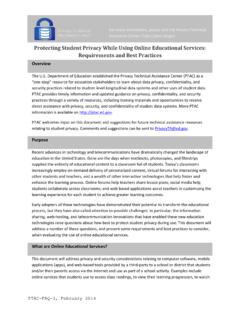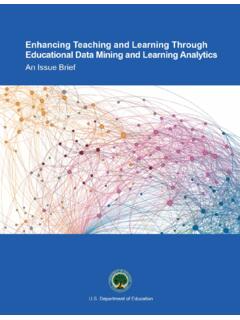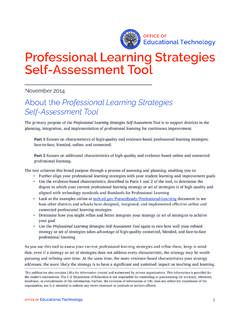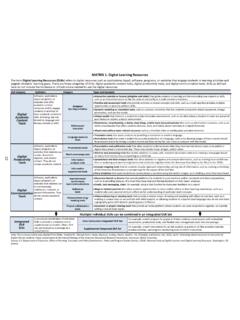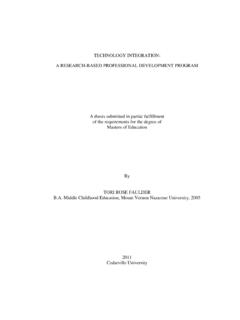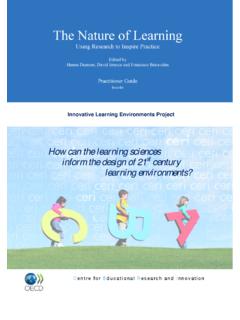Transcription of Understanding the Implications of Online Learning
1 Understanding the Implications of Online Learning for educational Productivity Department of Education Office of educational technology Prepared by: Marianne Bakia Linda Shear Yukie Toyama Austin Lasseter Center for technology in Learning SRI International January 2012 This report was prepared for the Department of Education under Contract number ED-01-CO-0040 Task 0010 with SRI International. The views expressed herein do not necessarily represent the positions or policies of the Department of Education. No official endorsement by the Department of Education is intended or should be inferred. Department of Education Arne Duncan Secretary Office of educational technology Karen Cator Director January 2012 This report is in the public domain.
2 Authorization to reproduce this report in whole or in part is granted. While permission to reprint this publication is not necessary, the suggested citation is: Department of Education, Office of educational technology , Understanding the Implications of Online Learning for educational Productivity, Washington, , 2012. This report is available on the Department s Web site at On request, this publication is available in alternate formats, such as Braille, large print, or computer diskette. For more information, please contact the Department s Alternate Format Center at (202) 260-0852 or (202) 260-0818. Technical Contact: Bernadette Adams Senior Policy Analyst Office of educational technology i Contents Exhibits.
3 Ii Acknowledgements .. iii Executive Summary .. v Introduction .. 1 Overview of Online Learning for Secondary Education .. 1 Purpose of this Report .. 3 Introduction to the Measurement of educational Productivity .. 5 Estimating Program Costs .. 8 Documenting Context and Implementation .. 10 Measuring Program Outcomes .. 10 Cost-Effectiveness research Requirements .. 12 The Productivity Potential of Online Learning .. 15 Opportunities to Reduce educational Costs Through Online Learning .. 25 Implications .. 33 The Need for Transformation .. 34 Suggestions for Future research .. 35 Appendix A: Additional Resources .. A-1 General Productivity in Education .. A-2 Productivity and educational A-3 Key Resources on Types and Prevalence of Online Learning .
4 A-13 Quality Standards for Online Learning Programs .. A-15 References .. A-17 ii Exhibits Exhibit 1: Components of educational Productivity Analyses .. 7 Exhibit 2: Comparison of Per-Pupil Spending .. 26 iii Acknowledgements This issue brief was developed under the guidance of Karen Cator and Bernadette Adams Yates of the Department of Education, Office of educational technology . At SRI International, Marie Bienkowski, Barbara Means and Robert Murphy provided advice and insightful feedback on earlier drafts of the report. Ashley Lee and Allison Steele provided research assistance. The report was edited by Michael Smith. Kate Borelli produced graphics and layout.
5 The authors made their best attempt to incorporate the thoughtful guidance provided by reviewers of earlier drafts of this report, including Cathy Cavanaugh (University of Florida), Fiona Hollands (Teachers College, Columbia University), Kemi Jona (Northwestern University), Glenn Kleiman (Friday Institute for educational Innovation), Robin Lake (University of Washington) and Henry Levin (Teachers College, Columbia University). The authors are grateful for their constructive comments. iv v Executive Summary educational systems are under increasing pressure to reduce costs while maintaining or improving outcomes for students. To improve educational productivity,1In the United States , Online Learning alternatives are proliferating rapidly.
6 Recent estimates suggest that million elementary and secondary students participated in some form of Online Learning in 2010 (Wicks 2010). The term Online Learning can be used to refer to a wide range of programs that use the Internet to provide instructional materials and facilitate interactions between teachers and students and in some cases among students as well. Online Learning can be fully Online , with all instruction taking place through the Internet, or Online elements can be combined with face-to-face interactions in what is known as blended Learning (Horn and Staker 2010). many school districts and states are turning to Online Learning . The purpose of this report is to support educational administrators and policymakers in becoming informed consumers of information about Online Learning and its potential impact on educational productivity.
7 The report provides foundational knowledge needed to examine and understand the potential contributions of Online Learning to educational productivity, including a conceptual framework for Understanding the necessary components of rigorous productivity analyses, drawing in particular on cost-effectiveness analysis as an accessible method in education. Five requirements for rigorous cost-effectiveness studies are described: 1) Important design components of an intervention are specified; 2) Both costs and outcomes are measured; 1 As defined in this report, productivity is a ratio between costs and outcomes that can be improved in one of three ways: by reducing costs while maintaining outcomes, improving outcomes while maintaining costs or transforming processes in a way that both reduces costs and improves outcomes.
8 Any improvements in productivity are likely to require initial investments, but successful efforts reduce costs over the long term, even after these initial investments are taken into account. vi 3) At least two conditions are compared; 4) Costs and outcomes are related using a single ratio for each model under study; 5) Other factors not related to the conditions being studied are controlled or held constant. The report also includes a review of ways that Online Learning might offer productivity benefits compared with traditional place-based schooling. Unfortunately, a review of the available research that examined the impact of Online Learning on educational productivity for secondary school students was found to be lacking.
9 No analyses were found that rigorously measured the productivity of an Online Learning system relative to place-based instruction in secondary the limitations of the research regarding the costs and effects of Online instruction for secondary students, the review that follows also draws on examples and research about the use of Online Learning for postsecondary instruction. While there are many differences between higher education and elementary and secondary education ( , age and maturity of students), postsecondary institutions have a broader and longer history with Online Learning than elementary and secondary schools. The intention is to use the literature from higher education to illustrate concepts that may apply to emerging practices in elementary and secondary education.
10 Findings from the studies of higher education should be applied with caution to secondary education, as student populations, Learning contexts and financial models are quite different across these levels of schooling. This lack of evidence supports the call of the National educational technology Plan ( Department of Education 2010a) for a national initiative to develop an ongoing research agenda dedicated to improving productivity in the education sector. The evidence summarized in this report draws on literature that addressed either costs or effectiveness. These studies typically were limited because they did not bring the two together in a productivity ratio and compare results with other alternatives.


